“It’s quite simple: The more iconic species you see on the Galapagos Islands, the more rewarding and memorable your experience will be!”
When it comes to wildlife, no place on Earth compares to the Galapagos Islands. Lumbering giant tortoises and curious sea lion pups amid dramatic volcanic landscapes let you feel what it was like before humans emerged on the planet. The vast diversity of animal life is what attracts visitors to this remote paradise. But the islands are far-flung, spread out over 138,000 Km2 (53,300 mi2), and impressing explorers from all corners of the World.
Because of this vastness, deciding where to go and what to observe in the archipelago can be quite a challenge. To tailor our itineraries and enable guests to absorb the best balance of Galapagos wildlife, we sought consensus among scholars, our Naturalist Guides and island connoisseurs to choose the archipelago’s most unique and fascinating wildlife. The list resulted in our BIG 15, and it captures the most iconic Galapagos wildlife. This is how explorers choose the ultimate voyage, and here we unfold for you the great features and greatness of the BIG 15.

GALAPAGOS ALBATROSS
Island Exclusive Species: Found only on Española Island
Also called the waved albatross, the Galapagos albatross (Phoebastria irrorata) iis the largest bird in the Galapagos, with a wingspan of up to 250 centimetres (8.2 feet). They breed exclusively on Española Island, except for a handful of albatross on the continental Ecuadorean island of La Plata. Close to 35,000 breeding pairs exist, but they have been considered critically endangered since 2007 due to the vulnerability of having a single main breeding site. Albatross have a spectacular mating dance of circling and audible clacking of beaks. Often considered fully monogamous, long-term behavioural research has proven that individuals do mate with birds with which they don’t share a nest.
Unlike most other animal species of the Galapagos, the waved albatross has a fairly predictable breeding cycle, and for a very good reason: all couples and hatchlings must leave Española before the winds fade away in mid-January. Being so large and heavy, any albatross staying on after that yearly change in weather patterns literally would be stranded until winds pick up again around April; hence, eggs are laid between April and June and incubated for two months. Albatross feed mainly on small fish, squid, and crustaceans.
When seasons switch back to the cooler, but dryer months, the albatross return to Española – most of them having scored many thousands of miles of foraging trips to the coastal oceans of mainland Ecuador and Peru in the process! They, in fact, spend very little time of their long lives atop dry ground. They either fly or sit calmly at sea most of their life. Land is for these big birds only a matter of reproduction. Among the BIG15, Galapagos albatross can only be seen on itineraries that explore Española Island in the southeast of the archipelago.
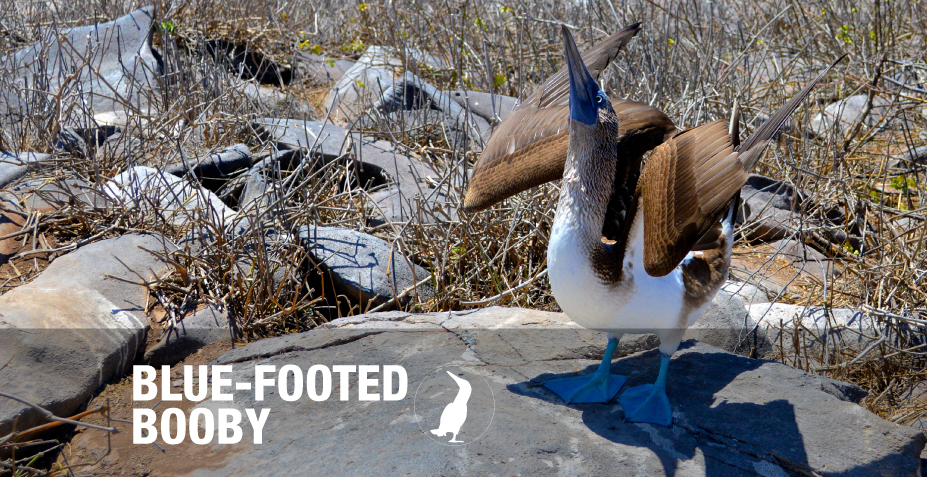
BLUE-FOOTED BOOBY
Best known for some of their notably colourful anatomical features, the three species of boobies that nest on the Galapagos belong to the Sulidae family of seabirds. Sometimes looking comical on land, they catch fish with spectacular plunge dives, often chasing fish while underwater. The Galapagos boobies are endemic as sub-species.
Visitors love the blue-footed boobies (Sula nebouxii) Their conspicuous, unreal-looking blue feet fascinate visitors, as well as their famous, amusing mating dance, during which the male shows off its feet in up-and-down movements to attract females. The most attractive feet for potential mates are those of a more turquoise blue, rather than the deep blue. The shade of blue is indicative of how good a male is at feeding himself, being linked to the amount of food it consumes. Females are actually slightly larger than males, measuring up to 90 centimetres (36 inches) in length, with a wingspan of up to 1.5 metres (4.9 feet). While they also nest in other parts of Latin America between the Pacific Coast of Mexico and Peru, around half of all blue-footed boobies live on the Galapagos.
At the same time, while these are generally the most commonly encountered boobies, they happen to be the ones with the smallest population. The most important breeding colonies exist on Española Island and North Seymour. But the dramatic sight of plunge-diving boobies may be witnessed on any given day throughout the archipelago’s waters. Reliant on diving into the sea to feed, their nostrils are fused, hence it breathes through the corners of its mouth. Unusually for boobies, they may raise more than one chick at a time, although during times of scarce food competition is harsh and first-hatched chicks may kill their smaller sibling (siblicide). The blue-footed booby is considered non-threatened. All itineraries will have contact with blue-footed boobies, and some explore their nesting colonies.

NAZCA BOOBY
Boobies have similar feeding strategies, but they tend to compete very harshly for nesting areas, particularly the Nazca booby (Sula granti). Some scholars argue they are a subspecies of the masked boobies, although a 2002 study provides genetic evidence that the Nazca booby is indeed a separate species, diverging from the masked booby around 400,000-500,000 years ago. It most obviously looks different from the masked booby by having a shorter, flatter orange rather than yellow beak. This largest booby present on the Galapagos, covered in snow-white plumage and with black feet, is the most violently competitive Darwinist among them all. They are bad neighbours, both to their own species, and to their cousins, the blue-footed boobies.
These birds mainly nest along the shoreline, up to 100 metres (300 feet) inland on Genovesa. Hatchlings regularly commit siblicide, mostly by pushing the smaller brother or sister out of the nest, without the parents taking any action. Female Nazca boobies do lay two eggs four to five days apart so that, if the first is broken or eaten, the second may yet produce an offspring. When flying, they can be identified by the black wing and tail feathers. Despite the toughness of its competitive life, it is also listed as non-threatened, with a population estimated at around 30,000, but its global number is estimated to be declining. They can be seen on Genovesa, Española, and Floreana.
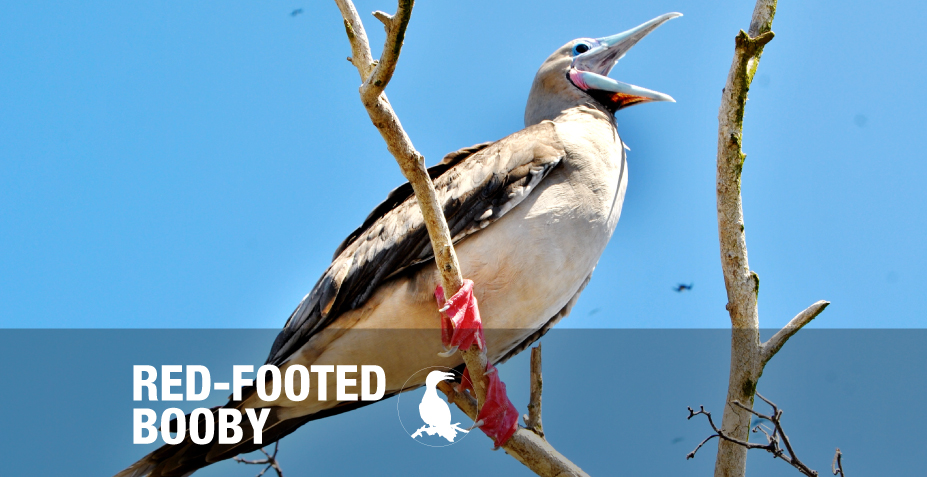
RED-FOOTED BOOBY
Limited Distribution Species: found on Genovesa, Punta Pitt (the eastern tip of San Cristóbal); small numbers breed on one of Floreana’s satellite islets, and a minute number nest on North Seymour.
Ironically, the least seen booby happens to be the most numerous on the archipelago: the red-footed booby (Sula sula). They nest mainly on Genovesa Island, as well as San Cristóbal, but may occasionally be seen elsewhere in the archipelago. For them, to live in the corners of the archipelago makes perfect sense, as these boobies forage on the outskirts of Galapagos waters. They have a particular taste for flying fish, which they catch thanks to their ability to fly at high speeds.
Individuals among this smallest Galapagos booby species grow to up to 77 centimetres (30 inches) in length, with a wingspan of up to 145 centimetres (57 inches). Its beak is light blue, turning to pink around the mouth and above the eyes, and its feet are characteristically red, with white claws.
Adults have feathers varying from white to brown tones. At the same time, hatchlings look much like the Nazca boobies, all in white with black beaks. They generally build their simple nests in low-lying branches of trees or bushes, unlike all other booby species. To do this, they have longer toes than other boobies, allowing them to grasp and hold on to twigs and branches. They lay only one egg. If it is lost, females may lay another within 10 to 40 days. Besides the Galapagos, they may also be found in a vast area of the Pacific Ocean, including Midway Island and Easter Island.
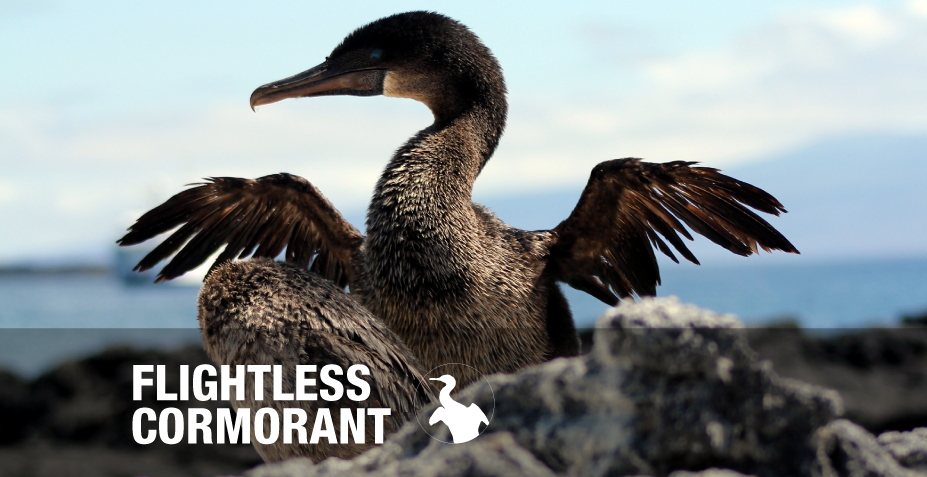
FLIGHTLESS (GALAPAGOS) CORMORANT
Limited Distribution Species: Found only on Fernandina and the west coast of Isabela.
The Galapagos or flightless cormorant (Phalacrocorax harrisi) is the rarest, biggest, and most unique cormorant. Its ancestor arrived in the archipelago around two million years ago, in fact even before Fernandina and Isabela, the islands where they now live, even existed. This bird probably evolved in the centre of the Galapagos before migrating west in tune with a major shift of high marine food productivity upon which it had come to rely.
Uniquely among cormorants and, except for penguins, marine birds overall, it lost its ability to fly, eased by the absence of terrestrial predators, but mainly to adapt to its need to grow a larger body to dive. Mostly it dives at depths of around 10-15 metres (33-45 feet), but can go as deep as 80 metres (260 feet) if necessary, such as during an El Niño. Adaptations to its feeding habits also include its feathers, which resemble fur and aren’t covered in oil, and its solid bones.
The most unusual trait of these birds may be their mating system: sex roles are partially reversed in courtship – i.e., females lead and are more active than males in courtship and compete aggressively for access to males. The female normally deserts its mate and offspring to re-mate serially with different males while males raise the young unaided. Due to their restricted range, they can only be encountered on voyages through the Western Islands.
*Scientific contributor: Dr. Carlos Valle, Universidad San Francisco de Quito, Ecuador

AMERICAN FLAMINGO
The flamingos present in the Galapagos belong to the American flamingo (Phoenicopterus ruber), but are an odd southwest outlier, considering that the remainder of the species breeds along coasts of Colombia and in much of the Caribbean. Despite its wide range, this species is in fact rarely found outside the Caribbean. These birds’ emblematic colour is linked to their diet (rich in carotenoids), and secretions from their uropygial gland near the base of the tail also transfer pigments to the plumage coat. Young flamingos lack the pink coat and feed on their parent’s “crop milk” secreted by another specialized gland in both male and female parents.
Flamingos have the largest and heaviest tongues among birds as the feeding techniques of baleen whales (rorquals) and flamingos are very similar: both are able to filter large amounts of very small food in very large quantities with the help of specialized filters, the baleen plates in the case of rorquals, and, in the case of flamingos, the lamellae, small plates in their mandibles.
Courtship rituals among flamingos form one of nature’s most impressive shows. Adult males and females aggregate in close groups and start an intricate dance with necks cocked up while flashing their primaries (the long flying feathers at the wing tips). These are exceptionally pink and black as they are less exposed to abrasion, wear and tear and other factors that may weaken the colour intensity.
Among the largest birds in the archipelago, American flamingos can stand up to 145 centimetres (57 inches) tall. The most recent bird-count registered 314 individuals of this species in the archipelago. Our guests can see American flamingos in all itineraries with few exceptions related to vessels exploring the Eastern Islands of the Galapagos.

FRIGATEBIRDS: GREAT AND MAGNIFICENT
Unusually, two different species of frigatebird coexist practically side by side on the Galapagos: the great (Fregata minor) and the magnificent (Fregata magnificens), the largest species of frigatebird. While they have a wide distribution through tropical oceans, there is nowhere one can approach them more closely than on the Galapagos. The magnificent is more pelagic, foraging for fish out at sea for long periods of time, while the great is more coastal. They catch most of their food on the wing, sometimes robbing other seabirds.
In their larger colonies, both species nest near each other. Males’ impressive red gullar sacks – which inflate to bright red heart-shaped balloons – are among the most eyecatching feature of Galapagos breeding colonies. It takes around a half hour for the sacks to inflate.
While our guides will help you pick out which is which, great frigate males inflate a slightly shorter gullar sack, but of a warmer red colour. Additionally, male great frigates have a green sheen on their shoulder plumage, while magnificent males have a purple sheen. The easiest to tell apart are juveniles and females: Magnificent frigate females have a black triangle of feathers running down from the base of the chin to the centre of their white chests.
As a result, a white “M” is visible from below. Great frigate females have white all the way up their chins. Juvenile magnificent frigates have a white head, while great frigate juveniles have a rusty tone. All Galapagos locations will have frigatebirds flying around, and top places to see their nesting colonies include San Cristóbal, Española, and Genovesa Islands.

GALAPAGOS HAWK
Outside the Galapagos, the animal on top of the food chain is a large carnivore like the jaguar in South America or the polar bear in the Arctic. In the archipelago, this distinction belongs to the Galapagos hawk (Buteo galapagoensis), a large endemic bird of prey. As the apex predator, it has no natural enemies, but is classified as vulnerable by the IUCN. Genetic investigation indicates that it is among the most recent native arrivals to the islands, having reached them around 300,000 years ago, compared with the famous finches, who arrived two to three million years ago.
They are present on most islands, but uncommon, with perhaps 150 breeding pairs. While they are unafraid of humans, people caused their extinction on Santa Cruz, Floreana, Southern Isabela, and San Cristóbal by introducing rival predators and through outright hunting. They are also absent on Genovesa. This natural exclusion seems to be linked to the fact that Genovesa has no lava lizards, the key food species of Galapagos hawks. They also prey on young land and marine iguanas, hatchlings of tortoises and sea turtles, as well as insects like locusts and centipedes. They may hunt in groups of up to three hawks and sometimes feed on carrion.
Of course, given the nature of diversity on the Galapagos Islands, the hawks show a significant variety of sizes, with wingspans ranging from 116cm (46 inches) on Marchena to the largest, with 140cm (55 inches), on Española.
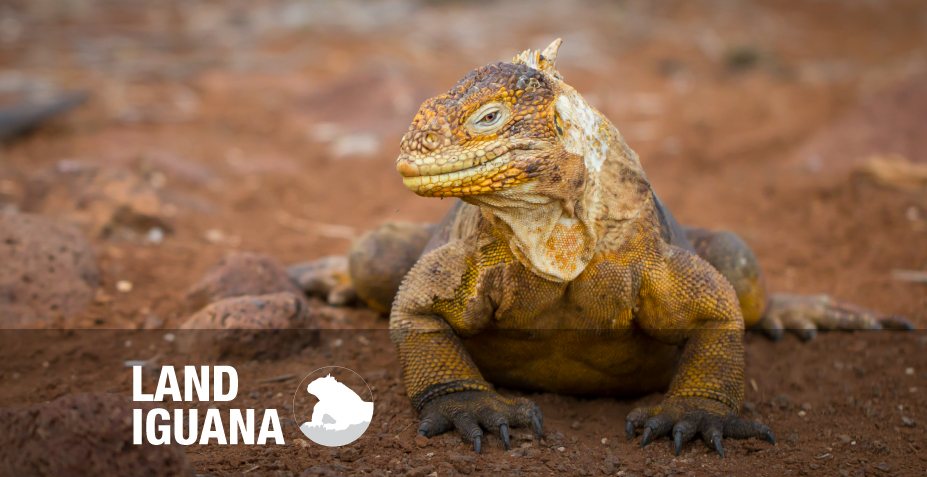
LAND IGUANA
On the Galapagos, land iguanas play an important role as endemic resident herbivores. Their largely vegetarian feeding habits are responsible for the dispersal of several succulent plants. The Galapagos land iguana (Conolophus subcristatus) lives on several islands, making it the most widely distributed land iguana of the three species of the Galapagos. The biggest adults can weigh 13 kilogrammes (30 pounds).
Nesting periods vary from island to islands, and females bury two to 20 eggs in burrows. Rare hybrids of land and marine are known to exist on little South Plaza Island, and both species can be seen there side by side.
Land iguanas feed mainly on plants (mostly cacti and other succulent plants, so they can survive long periods of time without the need to drink water), but may also feed on anything else available, even carrion.
To remove the small and annoying spines of cactus fruit, land iguanas are known to roll them repeatedly over sand and stones before eating them. These reptiles have a life expectancy of about 50 to 60 years. Invasive mammals have taken a strong toll on these iguanas, with rats attacking eggs, feral cats eating the young, and feral dogs the adults. Feral donkeys and goats compete with them for food.
The national park’s programmes to eradicate introduced species have helped the iguanas recover, allowing Galapagos land iguanas to be reintroduced on islands like Baltra where they had become extinct. Their current population is estimated between 5,000 and 10,000 animals. During the hot season (December-May) their courtship behaviour is quite amazing to observe with aggressive chasing, territorial displays, and the development of bright brown and yellow coloration in their skin.

MARINE IGUANA
The marine iguana (Amblyrhynchus cristatus) is one of the most amazing Galapagos species. Few species show such astonishing adaptations and evolutionary changes as these lizards, called “imps of darkness” by Charles Darwin. They arrived as terrestrial iguanas, and then evolved into their marine status and then spread throughout the archipelago. Their marine adaptations are a unique showcase of evolutionary biology. They are found on all Galapagos Islands – but nowhere else.
Their critical adaptations to a marine habitat include a reduced heartbeat and constriction of blood vessels near its skin to avoid temperature and oxygen loss. A shortened snout with small tricuspid teeth allow them to graze on the narrow algae they forage at low tide either submersed, especially in the case of larger iguanas, or those exposed by low tide favoured by smaller iguanas.
Marine iguanas also have a supersized supraorbital gland (marine birds also have this gland well developed) as a means of extracting excess salt from their blood flow, like kidneys, and sneeze it out several times in a day.
Their life span is shorter than land iguanas, believed to be around 40 years. All our guests see marine iguanas as they inhabit all islands, but they vary significantly from island to island. Guests who visit Genovesa island (all three vessels) will see the smallest and blackest marine iguanas (A. cristatus nanus ), guests visiting Fernandina and Northern Isabela, will see the largest marine iguanas (A. cristatus cristatus), and those visitors seeing Floreana and Española will see the most colourful subspecies (A. cristatus venutissimus ).
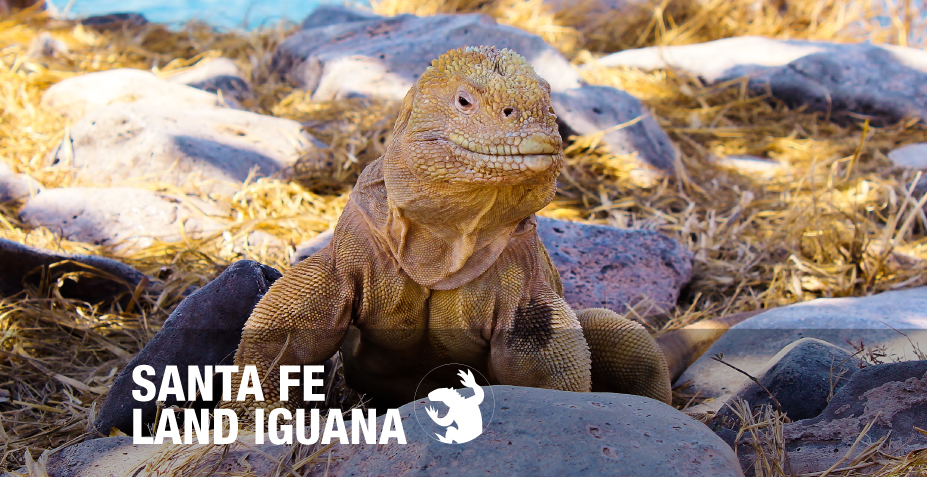
SANTA FE LAND IGUANA
Island Exclusive Species: occurs only on Santa Fe Island
The Santa Fe land iguana (Conolophus pallidus), with smaller dorsal spines and a more brownish colour and tapered snout, lives only on little Santa Fe, an island of 24 square kilometres (9.3 square miles), off the eastern coast of Santa Cruz Island, unlike its more widely distributed cousin, the Galapagos land iguana. Perfectly adapted by its colour to blend in with its surroundings, it is somewhat more difficult to observe than the other land iguana. It weighs up to 11 kilogrammes (25 pounds). Beyond their plant diet, which consists overwhelmingly of the island’s prickly-pear cactus, some individuals have been discovered to eat insects and carrion. In season, it loves the yellow flowers of the genus Portulaca.
Darwin’s finches sometimes feed off the bothersome parasites that can affect these reptiles. The Santa Fe land iguana is categorized as vulnerable given its tiny geographical distribution. The eradication of feral goats in 1971 has helped the species to survive, along with the endemic Santa Fe rat (Oryzomis bauri), one of very few native land mammals (all of them rodents) in the islands. The 3-11 eggs females lay take about 50 days to hatch in their burrows. This island-endemic reptile can only be seen on Santa Fe Island. If you have that herpetology bug, make sure this island is part of your voyage.

GALAPAGOS PENGUIN
Galapagos penguins (Spheniscus mendiculus) are the only penguins that live on the equator, the only penguins that moult twice a year, and, of the 18 species of penguins, they are the rarest. The Galapagos penguin is the second-smallest penguin and weighs about two kilogrammes. Males, generally larger and heavier than females, have thicker bills. The Galapagos penguin is the only species of penguin that has no set breeding season, can lay eggs up to three times in a year, and, when food is abundant, can raise two chicks in about three months.
These penguins can survive on the equator because their breeding biology is adapted to the unpredictable upwelling of productive, nutrient-rich water in the Galapagos archipelago. During breeding, they shed their feathers around their eyes and bill so they can lose heat, and they stand with their feet in the shade to avoid the hot black lava.
Penguins have no sweat glands, so when they get hot, they pant to keep cool or jump into the water. They seek shade to lay their eggs and raise their chicks. Lava tubes and crevices just above the highest tides make good nest sites.
The current population is less than half of what it was in the early 1970s, with somewhere between 1,500 and 4,700 individuals. The population of Galapagos penguins has not recovered because of several severe El Niños in the 1980s and 1990s and the introduction by whalers of predators like rats and cats to the islands.
* Scientific contributor:Prof. Dee Boursma, University of Washington, USA
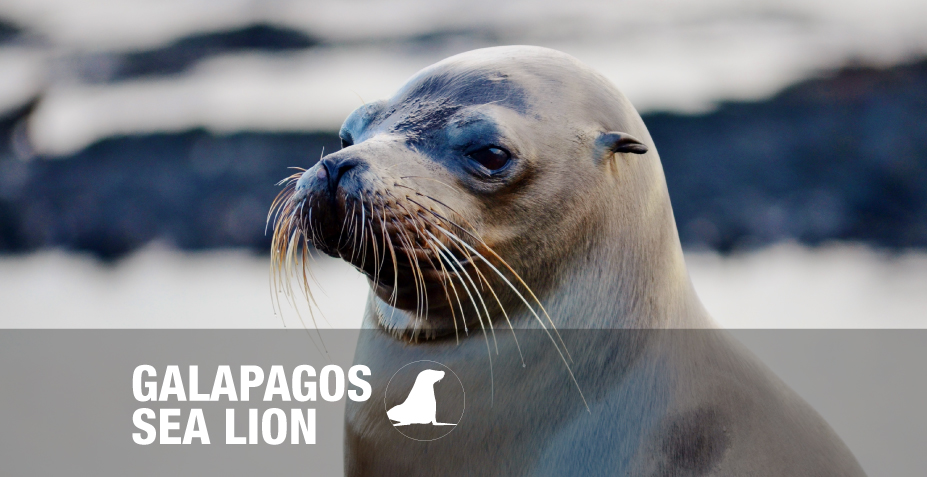
GALAPAGOS SEA LION
The Galapagos sea lion (Zalophus wollebaeckii) is a particularly interesting seal species since it lives right on the equator, exposed to greater heat and potentially less food than colder-climate species. The productivity of the Galapagos, as well as the sea lion’s adaptations, allow it to thrive nonetheless. This is the smallest species of sea lion, with females weighing around 75 kilogrammes (165 pounds) and males up to about 200 kilogrammes (440 pounds). Its ancestor apparently reached the archipelago around 1.2 million years ago, and the species currently numbers around 20,000 individuals. El Niño events also impact their population by reducing food supply.
They live throughout the Galapagos, but most densely in the central islands. Nonetheless, given that they are an endemic species in a small area, they are listed as endangered. Excellent divers, they can descend up to 580 metres (1,900 feet), although they mostly look for food in the top 100 metres (330 feet) below the waterline, day or night. Visitors may see sea lion pups during most of the year. Most births are October and November, but on South Plaza, breeding season extends from July through April. During this time, dominant males defend their territories – and harems – along the shore, living off their fat reserves, while smaller males may try to sneak in and find a mate. After giving birth, mothers stay with their pups for five to seven day, later alternating between one to four days of hunting in the ocean and one day of suckling ashore. The length of time pups stay with their mother varies considerably: On Fernandina, they become independent after just a year, while this takes two to three years in the central islands. They are seen on all of our itineraries.
* Scientific contributor: Prof. emeritus Fritz Trillmich, Universität Bielefeld, Germany

GALAPAGOS FUR SEAL
The Galapagos fur seal (Arctocephalus galapagoensis) is the smallest of all seals, with females weighing just around 30 kilogrammes (66 pounds) and males around 80 (176). It appears to have arrived in the archipelago relatively recently and is more similar to its mainland relative than the Galapagos sea lion. It currently numbers around 15,000 individuals but can be highly susceptible to El Niño events, during which many young risk starving.
They live mostly on Fernandina and the western side of Isabela, but can often be seen in other parts of the Galapagos, notably Puerto Egas, North Seymour, and Genovesa. Solitary males can occasionally be found all over the archipelago. During breeding season, between September and December, males however defend their territories for two weeks to a month at a time, living off their fat reserves.
After giving birth on land, mothers stay with their young for five to seven days straight. Pups stay with their mothers for two to three years; should another youngster be born during that time, both compete sharply for food, and the younger one generally starves.
Galapagos fur seals tend to hunt well offshore at depths between 60 and 100 metres (200 and 330 feet), seeking fish and squid that at night tend to rise to these depths from further down. The bright light of the moon can keep this ascent from happening, so that most fur seals tend to spend nights close to full moon on land.
* Scientific contributor: Prof. emeritus Fritz Trillmich, Universität Bielefeld, Germany
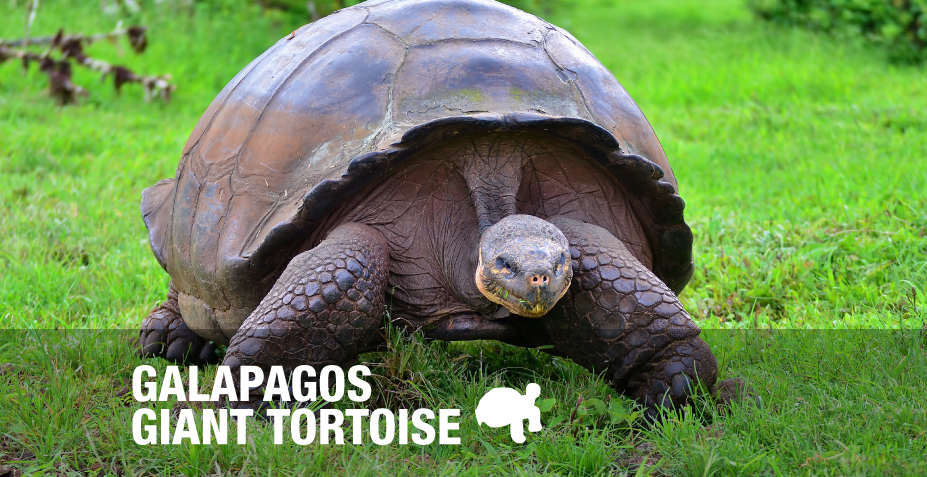
GALAPAGOS GIANT TORTOISE
The Galapagos giant tortoise (Chelonoidis nigra) is the largest living tortoise species. Weighing up to 250kg (550 pounds) and numbering perhaps 200,000 before humans discovered the islands, their huge size led 16th-century Spanish explorers to apply their Spanish name to the whole archipelago. The islands’ dominant plant eater, they play an important role as their habitats’ top grazer. In the wild, these gentle giants slowly barrel their way through the plant cover. The shape of their shells varies from island to island and, on Isabela, from volcano to volcano. Islands with humid climate have larger tortoises with domed shells and shorter necks; dry climates lead to somewhat smaller tortoises with “saddleback” shells and long necks. Growing slowly, they often live to become well over 100 years.
Hunting by whalers and others took a steep toll on the giant tortoises and their numbers plunged, with five of fifteen subspecies becoming eradicated. Breeding programmes have however led to a recovery, and Galapagos giant tortoises now number close to 20,000. Rats and feral cats and dogs still pose a threat to nests, attacking eggs and freshly hatched tortoises. Young tortoises are therefore kept until they have grown large enough to be safely released into the wild. Inside the Galapagos National Park, visitors can see them at Urbina Bay on the Western Islands itineraries; they can also be seen in their natural habitat in the highlands of Santa Cruz and also at breeding centres in Puerto Ayora and at Cerro Colorado on San Cristóbal.
This blog post was originally posted on Metropolitan-Touring.com.